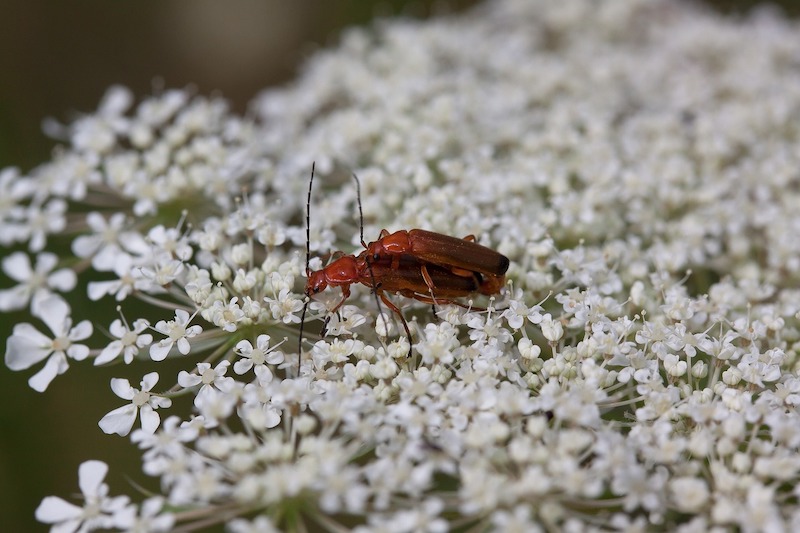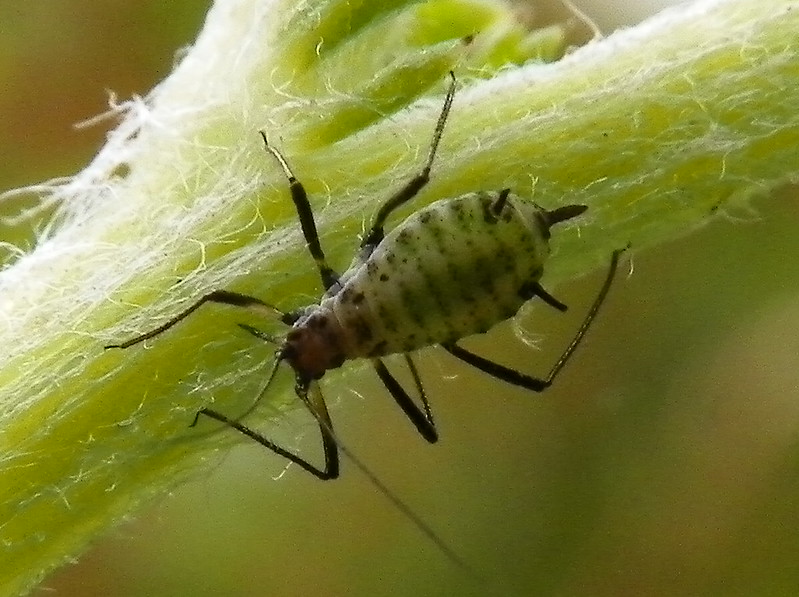Yarrow is a great perennial to incorporate into your home garden, open meadow plan, or pollinator-friendly garden. This drought-tolerant plant is rarely bothered by pests. In fact, this plant attracts and is often used as food and shelter for beneficial insects and their larvae.
The three most common pests are easily managed when discovered and diagnosed early. Aphids, mealybugs, and spittlebugs are sap-sucking insects that are attracted to plants with fresh, juicy, and dense foliage early in the season. Spittlebugs only appear for a short window and generally only cause cosmetic damage.

Common Yarrow Pests
Aphids
Aphids come in many different colors but they all do the same type of damage to plants. These small (.05 -.10 of an inch long) insects hatch from overwintered eggs laid at the base of Yarrow and feed on the fresh new growth of foliage and flower stems early in the spring. Affected foliage can have a twisted and distorted appearance, while flower buds may be much smaller than usual and fail to open altogether.
As they feed, aphids also excrete a sticky liquid called Honeydew. In large outbreaks, this Honeydew can build up to the point that it drips onto other parts of the plant, the ground, or surrounding plants and will attract ants who harvest the sugar-rich liquid. Sooty mold is a secondary infection that occurs as fungal spores blow through the air and are trapped in the Honeydew.

Photo by Peter O'Connor, unmodified, Flickr, Copyright CC BY-SA 2.0
Treating Aphids on Yarrow
Aphids can be washed off plants with a sharp spray of water from the hose. Carefully spray both the top and bottom of the leaves, concentrating on the leaf and stem joints where the adults typically lay the next generation of eggs. The treatment may have to be repeated a couple more times to control a large outbreak. The affected stems and foliage can also be removed if the damage is restricted to a small portion of the plant.
Yarrow will quickly regrow when cut back, especially early in the growing season. Any late-season aphid damage will die back as the plant goes dormant for the winter. New fresh growth will replace the old spent top growth the following spring.
Preventing Aphids on Yarrow
Yarrow prefers lean soil on the dry side. Over-fertilizing or overwatering will encourage lush, weak top growth that is attractive to aphids. Often, no extra fertilizing is required when plants are mulched with organic material (finely shredded, bark, arborist chips, or compost) on a yearly basis. Grow Yarrow in full sun so that growth remains strong and healthy throughout the season. Make sure to remove any fallen leaves or stems at the end of the season to prevent Aphid eggs from overwintering near the plants. This garden clean-up will break the life cycle and reduce future outbreaks.
Mealybugs
Mealybugs are most often associated with greenhouse-grown plants and houseplants but are also found on landscape plants in climates with dry summers. The insects are very small (.125 of an inch in length) and often covered in a powdery, waxy, or fuzzy substance that protects them from predators.
Mealybugs will settle into an area of the plant and suck sap from the leaves and stems until they are ready to move and lay eggs. Generations of Mealybugs can reproduce in as little as 2 weeks and fluctuate based on daily temperatures, often going into a dormant state during the hottest days of summer. Large infestations cause yellowing of the foliage, slowed growth, and eventual death. Mealybugs also excrete Honeydew, which attracts ants and sooty mold infestations.
Treating Mealybugs on Yarrow
Small outbreaks of Mealybugs are easily wiped off with a cotton pad soaked in isopropyl alcohol or handpicked from the foliage. Horticultural soap sprays are not effective against this pest because they cannot penetrate the coatings that Mealybugs develop. A secondary infestation of ants will need to be treated if you want to get rid of the mealybugs. Ants will take on the role of guards to protect their supply of Honeydew. Herbaceous perennials such as Yarrow will outgrow any Mealybug damage that occurs early in the season. Late-season damage will be replaced with fresh, new growth in the spring.
Preventing Mealybugs on Yarrow
Inspect any new plants brought in from outside nurseries or plant swaps. Sticky leaves or fuzzy growths near branches or leaves indicate the presence of mealybugs or other sap-sucking insects. Good garden hygiene during the growing season and before the plant goes dormant will help to remove any eggs or adults that may try to overwinter. Supplemental watering during dry periods will keep the plant hydrated and healthy so that it is better able to fend off attacks from pests.
Spittlebugs
Early in the summer, some perennials will exhibit masses of frothy bubbles on their leaf joints and stems. This is a protective covering that spittlebugs use to keep themselves hydrated and safe from predators until they can mature enough to lay eggs for the next growing season. Spittlebugs cause little damage to host plants and are only an obvious pest for a short time. Sometimes there is a slight crumpling of the leaves that are being fed on, but these minute insects do not do lasting damage. Spittlebugs only produce one set of eggs a year no matter the climate that they are in.

Photo by Bonnie James, cropped, Flickr, Copyright CC by 2.0
Treating Spittlebugs on Yarrow
A sharp blast of water from the hose is enough to remove the spittle and the bugs from most plants. Be careful not to spray new foliage too hard. Using a gloved hand to wipe the spittlebugs off is also effective and disrupts the life cycle so that a new generation of eggs will not be laid.
Preventing Spittlebugs on Yarrow
Encouraging beneficial predatory insects in your garden will help to keep populations of spittlebugs low and/or unnoticeable. Predatory wasps are the most likely to feast on spittlebugs, although lacewings, lady beetles, and syrphid flies all are great to have in a healthy garden biosphere.
Beneficial Insects
Maybe the best reason to grow Yarrow in the garden is that it is the preferred host plant for a wide variety of beneficial predators and pollinators. Lady beetles, hoverflies, and predatory wasps all feed on the nectar and help to keep beneficial insects and pests in a balanced state. Yarrow is also a host for caterpillars of a wide variety of moths. Leaves that appear tattered and skeletonized may be supporting a caterpillar until it is ready to pupate into an adult. This damage will quickly recover.
Treating Beneficial Insects on Yarrow
The best way to keep beneficial insects in your garden is to avoid using broad-spectrum insecticides. These sprays, whether synthetic or organic, may be useful for getting rid of pest problems, but they also get rid of the ‘good’ bugs.
Encouraging Beneficial Insects on Yarrow
Do not use broad-spectrum insecticides, which can kill all bugs. Include plants that beneficial insects use for nectar. Letting some vegetables such as carrots, fennel, and kale go to seed will provide food and natural cover for flying insects and predatory spiders. Leave a few areas in your garden “wild” over the winter by allowing the plants to set seed and die back naturally until garden cleanup in late spring. Monitor for pests, but wait to take action until the beneficial insects have had a chance to help out. Use mechanical means of control such as pruning affected plant material and using a strong stream of water to get rid of pests.
Yarrow Pests Chart
|
Pest |
Identifying |
Treating |
|
Aphids |
Tiny, soft-bodied insects, typically green, yellow, brown, red, or black |
Wash off plants with a sharp spray of water from the hose |
|
Mealybugs |
Very small (.125 of an inch in length) and often covered in a powdery, waxy, or fuzzy substance |
Wipe off with a cotton pad soaked in isopropyl alcohol or handpicked from the foliage |
|
Spittlebugs |
Masses of frothy bubbles on their leaf joints and stems |
Spray with a sharp blast of water from the hose |
Sources: "Common Yarrow." The United States Department of Agriculture, Natural Resources Conservation Service. nrcs.usda.gov
 |
Author Robbin Small - Published 8-12-2023 |
